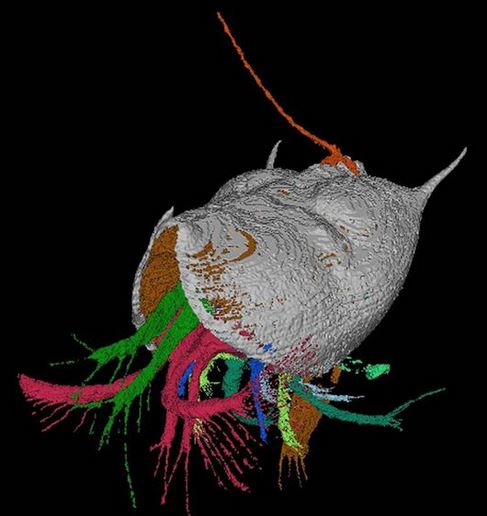A new species of fossil has been discovered in England – a 425-million-year old tongue worm – a prehistoric parasitic intruder that was found intact with its host, where it lived in its respiratory system.
The international team of researchers, led by the University of Leicester, found the specimen in the Welsh borderland in Herefordshire. The specimens, ranging from 1 to 4 millimetres long, were ‘exceptionally well preserved’.
The tongue worm had a body resembling a worm – hence the name – two pairs of limbs and a head. The parasite survived with the respiratory system of the host, which it entered when it was eaten.
The new fossil was entirely soft-bodied when it was alive. It is the first fossil tongue worm species to be found associated with its host, which in this case was a type of ostracod – a group of micro-arthropods with two shells that are joined at a hinge. Examples of micro-arthropods include insects, spiders and crabs.
 The tongue worm (in orange) attached externally to the shell of its host. The host, an ostracod, is using its limbs to swim forward. (Image: University of Leicester)
The tongue worm (in orange) attached externally to the shell of its host. The host, an ostracod, is using its limbs to swim forward. (Image: University of Leicester)
Professor David Siveter, who works at the Department of Geology at the University of Leicester, discovered the fossil with host together with scientists from Imperial College London, the University of Oxford, both in the UK, and Yale University in the US.
They published their findings in the academic journal Current Biology. The study was supported by the Yale Peabody Museum of Natural History, the John Fell Oxford University Press (OUP) Research Fund, The Natural Environmental Research Council, and the Leverhulme Trust.
External parasites
Professor Siveter explained:
“This discovery is important not only because examples of parasites are exceptionally rare in the fossil record, but also because the possible host of fossil tongue worms – and the origin of the lifestyle of tongue worms – has been the subject of much debate.”
“This discovery affirms that tongue worms were ‘external’ parasites on marine invertebrate animals at least 425 million years ago; it also suggests that tongue worms likely found their way into land-based environments and associated hosts in parallel with the movement of vertebrates onto the land by some 125 million years later.”
Despite their name, tongue worms, known scientifically as pentastomids, are not worms at all. They are a rare group of very small and widespread parasitic arthropods. Their fossils are extremely rare, and were only known about from isolated juvenile specimens, that is, until now.
In the world today, they are known from around 140 species, almost all of them existing within vertebrate hosts, particularly reptiles – humans can be hosts.
Some of the fossilized tongue worm specimens occur within the shell, near the ostracod’s eggs, while others are attached to the surface on the outside of its shell, which is a unique position for any fossil or living tongue worm.
Professor Siveter said:
“The tongue worm and its host lived in a sea that 425 million years ago – during the Silurian period of geological time – covered much of southern Britain, which was positioned then in warm southerly subtropical latitudes.”
“The animals died and were preserved when a volcanic ash rained down upon them. The new species has been named Invavita piratica, which means an ‘ancient intruder’ and ‘piracy’, referring to its parasitic lifestyle in the sea.”
The researchers have reconstructed the fossils using 3D computer modelling.
Citation: “A 425-Million-Year-Old Silurian Pentastomid Parasitic on Ostracods,” David J. Siveter, Derek E.G. Briggs, Derek J. Siveter and Mark D. Sutton. Current Biology. Published 21 May, 2015. DOI: 10.1016/j.cub.2015.04.035.
